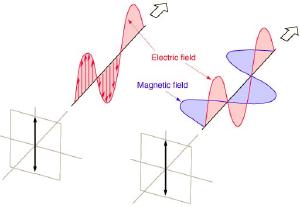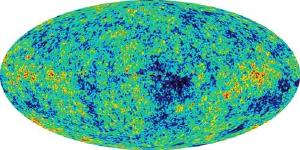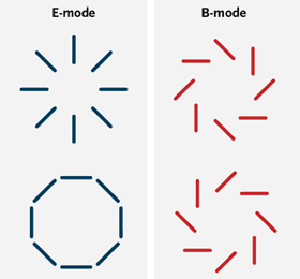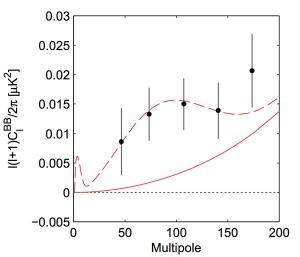Blog
Echoes
18 March 2014
 BICEP2 Collaboration
BICEP2 CollaborationYesterday a research project known as BICEP2 announced important results regarding cosmic inflation.1 The result centers on what is known as B-mode polarization in the cosmic microwave background. This is pretty big news, but it is also pretty complex, so let’s look at what’s really going on here and why this matters.
 Hyperphysics
HyperphysicsLet’s start with the idea of polarization. Light waves are a type of wave known as transverse waves. This means their oscillation is perpendicular to their direction of travel. You can see this in water waves, where the up and down motion of the wave is perpendicular to its motion along the water’s surface. With light waves (and electromagnetic waves in general), the vibration is that of the electric and magnetic fields.
Because of this, transverse waves can have an orientation to them known as polarization. If you imagine a vibrating string, the waves could move up and down, or side to side, or at some angle. There are other types of polarization that are more complex, but you get the idea.
Generally, the light emitted by a hot source is randomly oriented, or “unpolarized”. However if light scatters off a material it can be polarized by the interaction. The atmosphere does this to sunlight a bit, which I’ve written about before. This is why a good pair of polarized sunglasses can eliminate glare. They block light with horizontal polarization, which most reflections have. Polarization happens in scattering when source of light is not uniform. For example, polarized scattering occurs in the atmosphere because sunlight comes from the direction of the Sun, not evenly across the sky. If daylight came equally in all directions, then you wouldn’t see the scattering polarization.
 WMAP
WMAPSo what does this have to do with the cosmic microwave background (CMB)? The CMB is the light from the earliest point where the universe became transparent. That is, when the universe finally became cool enough for atoms to form. Before that point, the electrons and nuclei were too hot to come together, meaning that they were a thick plasma of charged particles. The light would keep scattering off the charged particles and couldn’t travel freely. In the last moments of this plasma stage, when the electrons finally started to bond with nuclei, the photons created in the big bang would have one last scatter off an electron before making its long journey across the universe. Now if the early universe were perfectly uniform, then we wouldn’t see any polarization from that last scattering. But there were small variations in the early universe, so we would expect to see some polarization in the CMB. Since this last scattering occurred at a particular moment in the early universe, cosmic polarization gives is a precise window into the earliest moments of the big bang.
 Sky and Telescope
Sky and TelescopeBecause of these small variations, the polarization of the CMB varies at different points of the sky. To get an understanding of the structure of the early universe, we need to look at the overall distribution of polarization across the sky. This is where the different “modes” of polarization come in. You can imagine the polarization measurement at each point can be represented by a line. Where the lines appear to follow a path, or appear to radiate out from a particular region, then that is known as E-mode polarization. Where the lines appear to twist relative to each other, that is known as B-mode polarization. They are so named because their orientations are similar to those simple electric (E) or magnetic (B) fields.
These two modes are important because they have different causes. The E-mode polarization is caused by the variations in density and temperature in the early universe, so it should follow the same pattern as the temperature variations seen in the cosmic background. This was first observed in 2002 by the DASI interferometer, and the results agreed with the temperature fluctuations as expected.
 NASA
NASAThe B-mode polarization has two causes. The first is due to gravitational lensing of the E-mode. The cosmic microwave background we see today has travelled for more than 13 billion years before reaching us. Along its journey some of it has passed close enough to galaxies and the like to be gravitationally lensed. This gravitational lensing twists the polarization a bit, giving some of it a B-mode polarization. It is this polarization that was observed for the first time this past July.
But there is another mechanism for B-mode polarization that is more subtle, and requires more data to observe. This mode is due to gravitational waves produced during the inflationary period of the big bang. You see, the cosmic background only has small fluctuations, and we aren’t sure why. Given the size and age of the universe at that time, its temperature shouldn’t have been able to even out.
 Alan Guth
Alan GuthWe think the solution is that the universe was incredibly tiny in its earliest moments, but soon entered an inflationary period where the observable universe expanded at a furious pace. This would explain not only the evenness of the cosmic background, but also why the universe is flat. We’ve never seen direct evidence of this inflationary period, but we should be able to observe the effect of inflation in B-mode polarization. If the inflationary period occurred, then it would have produced gravitational waves on a cosmic scale. Just as the gravitational lensing produces B-mode polarization, the gravitational waves would produce a B-mode effect. Observe this subtle B-mode, and you have direct evidence of the inflationary period.
 BICEP2
BICEP2Which brings us to this new work. What the team has found is evidence of more B-mode polarization than expected by gravitational lensing alone. Since there are two ways in which B-mode polarization can occur, they needed to show that this “extra” was not just due to lensing. They found that the extra B-mode polarization was seen at a five-sigma level, which means (barring a 1 in 2 million fluke) the excess is due to primordial gravitational waves. So we can say that primordial gravitational waves are real.
They then analyzed the polarization to determine the strength of these waves, and this is where things get interesting. Gravitational waves are measured in terms of what is known as an r factor, where a larger r means stronger gravitational waves and therefore stronger inflation. Results from the Planck space telescope determined that the upper limit of r should be r < 0.11.2 What these new results find is r is between 0.15 and 0.27, with the best result being r = 0.2. This is much higher than expected, and it conflicts with the Planck results. Or at least it seems to. Analyzing this kind of data is very tricky, so this may be an effect of how the data is analyzed, or it may be an effect of real physics.
So where do we stand with all this? Although the research is now public, it has yet to be peer reviewed. So it is worth being a bit cautious about these results. The next thing we’ll look towards is new research from the Planck telescope team. They are currently analyzing their own B-mode polarization data, and if this r=0.2 result is valid Planck will see it as well. Then there is the question of how to resolve the apparent conflict between the initial Planck result and this new one. It should also be kept in mind that while these results are consistent with the inflationary model, there are other less popular models that haven’t been ruled out. Personally I find the evidence for inflation pretty convincing, but I could be wrong.
At the same time, I don’t want to downplay this result too much. The result is very strong, and it points pretty clearly at inflation. If it holds up, it means we are now able to study the earliest moments of the universe. Much earlier than we have before. After all, the inflationary period ended when the universe was about 10−32 of a second old.
And we can see echoes of it from 13.8 billion years away.